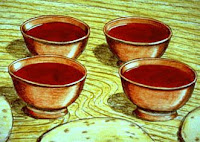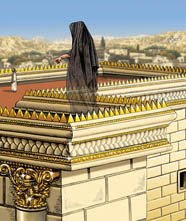
I had an email this morning from a pastor in Virginia asking if I knew what an ancient 'Passover' cup might have looked like?
I haven't illustrated the 'Lords Supper' as yet, so I've not done any research along these lines.
I know that Passover cups of today are fairly ornate like the one pictured, but did they have special cups that were kept just for the Passover meal in the first century, or would the Lord Jesus have used a normal pot, limestone or wooden cup supplied by the owner of the upper room?
I thought I might throw this question open to our regular readers, Bible artists and of course our resident researchers!
I was tempted to call this post 'The Quest for the Holy Grail' but I resisted!
Photo © www.judaica-mall.com
Update 20 July 08:
Dr Leen Ritmeyer kindly emailed me last night with an answer to the above question. He also sent one of his very helpful pictures to illustrate the point.
 One of the subjects discussed in our book "The Ritual of the Temple in the time of Christ" is the passover cup, or rather cups, for 4 cups were, and still are, used in the Passover ritual. Here is a passage of our six-page treatment of Passover: "The four cups of wine stipulated in Pesachim 10.1 (an ancient Jewish tract on Passover) as obligatory to be drunk during the feast symbolize four expressions of redemption used in the words of God to Israel in Exodus 6.6-7: "I will bring you out", "I will rid you out of their bondage", "I will redeem you" and "I will take you to me".
One of the subjects discussed in our book "The Ritual of the Temple in the time of Christ" is the passover cup, or rather cups, for 4 cups were, and still are, used in the Passover ritual. Here is a passage of our six-page treatment of Passover: "The four cups of wine stipulated in Pesachim 10.1 (an ancient Jewish tract on Passover) as obligatory to be drunk during the feast symbolize four expressions of redemption used in the words of God to Israel in Exodus 6.6-7: "I will bring you out", "I will rid you out of their bondage", "I will redeem you" and "I will take you to me". The cups were made of ordinary pottery - no holy grail, as you can see! Here is my illustration (above) of the 4 cups, which is based on actual cups that have been excavated.
Recently we attended a Passover ceremony at the Rabbi of Adelaide's house in Australia and indeed four cups of wine were drunk.
If you would read the Passover account in Luke chapter 22, you will see that two cups are mentioned, one in vs. 17 and one in vs. 20, while vs. 18 indicates that he did not drink the fourth or last cup, for "the Fruit of the Vine" was the collective name for all four cups.
© Ritmeyer.com
Thanks Leen! There's also a short video that can be viewed here that backs up Dr Ritmeyer's comments.
Other 'Question' posts:
What did Jesus look like?
What did Herod's Temple look like?
What do Angels look like?
What do Cherubs look like?






